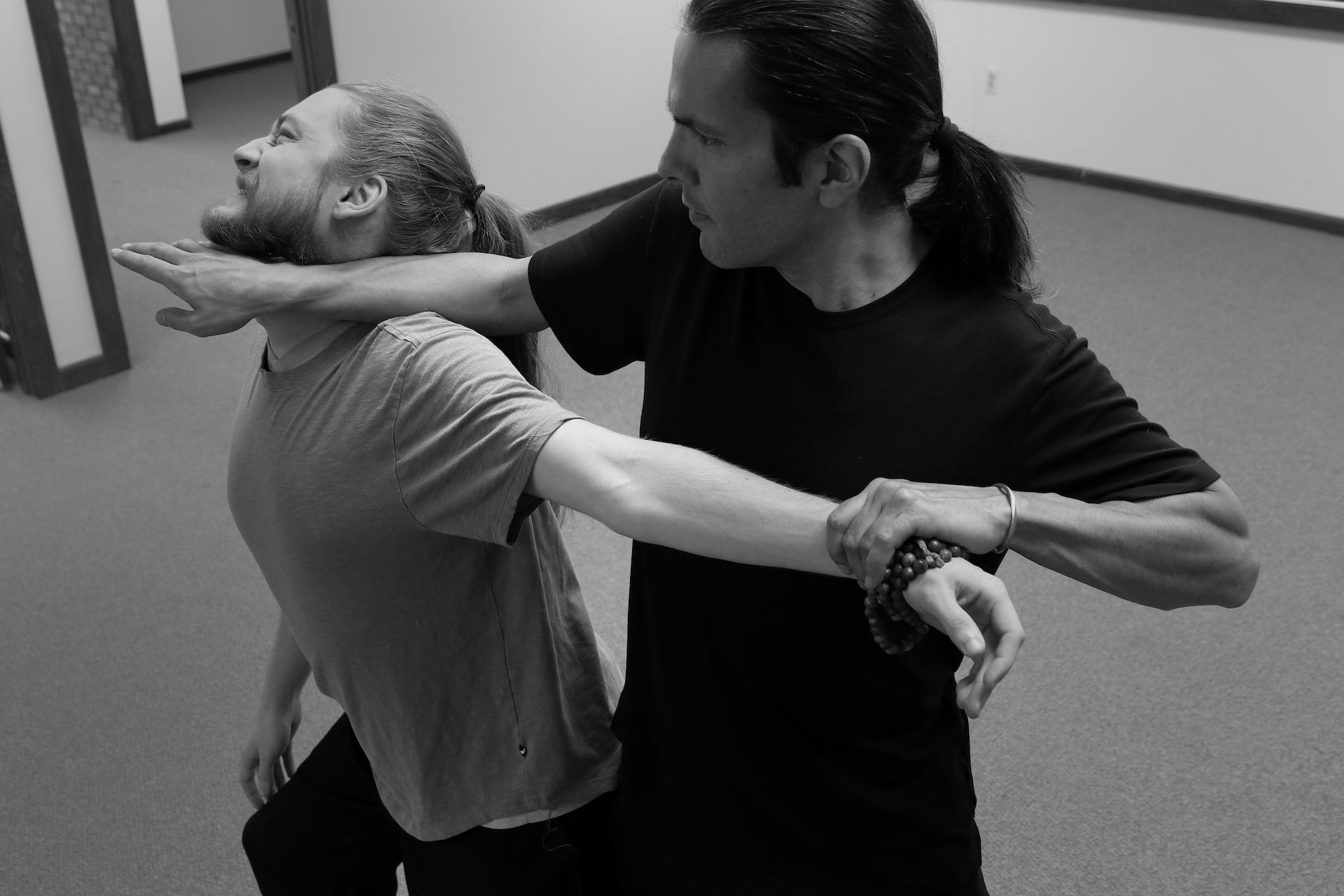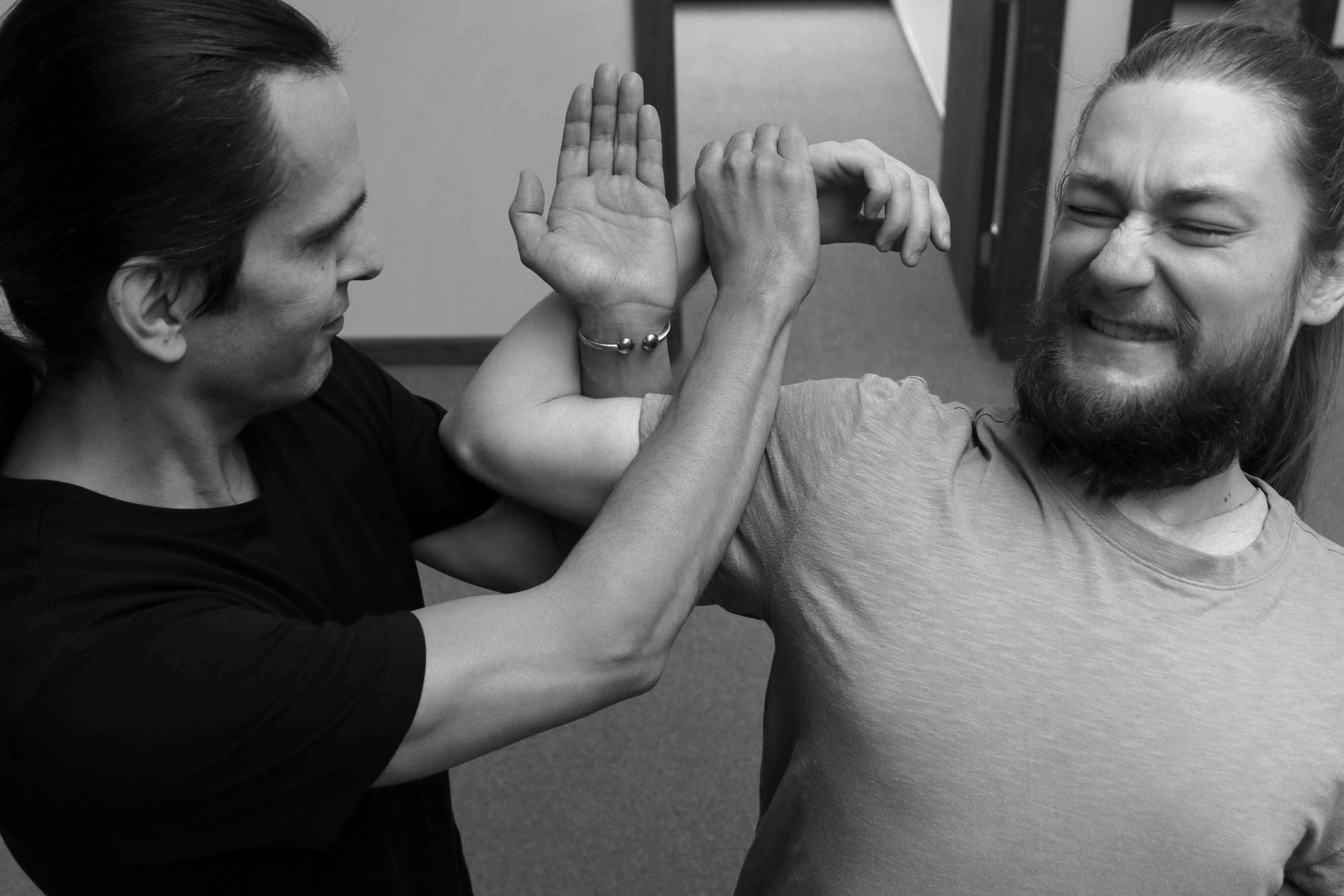
10 minute read
Tai Chi Chuan, Making the Intangible Tangible Piercing Eagle Feather [John Aldred
from Lift Hands Volume 20 December 2021 - The Multi-Award Winning Martial Arts Magazine
by Nasser Butt
The best way to progress and improve in Tai Chi Chuan is to attend to the basics, and one of the most fundamental basics in Tai Chi is attention to correct posture when practicing your form. Correct body alignment is how we transform the intangible elements of Tai Chi to a tangible expression of the main principles of Tai Chi Chuan.
The Basic Principles of Tai Chi Chuan:
1. Maintain mind intent and purity of motive 2. Keep your eyes open, inquisitive, and relaxed 3. Practice profound relaxation (Sung) 4. Be soft like water 5. Sink your weight and root like a tree 6. Breathe naturally, lightly through the nose, and rest the tongue on the roof of the mouth 7. Have a straight but limber and flexible spine (A string lightly pulling at Baihui – Du Mai 20) 8. Maintain a weight separated stance (Not double weighted) 9. Turn from the waist (Millstone grinding) 10. Use correct and adept hand positions and applications 11. Move with centeredness with focus on the movement and sensation of energy throughout the body 12. Apply slow deliberate movements 13. Maintain a continuous flow of movement without interruption 14. Express silk reeling movement from the feet and throughout the body 15. Lead with the mind, be mindful and mindless. 16. Be aware and connected to the environment around you 17. Swim gently through the air around you 18. Be amazed and open to the possibilities and experiences that present themselves to you
When a practitioner of Tai Chi manifests proper posture they begin to feel comfortable and relaxed when practicing or executing the Tai Chi postures and that comfort and relaxation leads to inner harmony and unity within all the elements that comprise Tai Chi Chuan.
Tai Chi Chuan is commonly translated to mean “Grand Ultimate Boxing”. This description of Tai Chi Chuan invites the Tai Chi practitioner to the highest expression of “the best boxing art”. To achieve the “Grand Ultimate” you must practice Tai Chi with diligent attention to each posture to manifest the basic principles of Tai Chi through each posture in a Tai Chi form. If you are looking to understand why Tai Chi Chuan is considered by many experts in the field as one of the best martial arts, then you need to participate and practice a form of Tai Chi Chuan that will help foster this ability within yourself.
When a Tai Chi practitioner gets to the point in their practice where they know a traditional long form, they can begin to experience the sensation of “ebb and flow," or what some might call the “sensation of chi” within their body and through their limbs. Once you begin to experience this sensation, then a reasonable question might come up regarding “Why am I feeling this sensation? Why am I experiencing these sensations, what are they, and what do they mean?”
Photo Credit: Abbas Ali

There are times when words are inadequate to explain higher concepts or experiences, and this may be one of those times. This is the intangible nature of Tai Chi Chuan as an internal martial art. The truth of “why” may be found in the “chaining” of each posture through one continuous flow of movement and the correct alignment of the body’s mechanics throughout the movements and the transitions between them.
Tai Chi has been described as “meditation in motion” and perhaps in nature we can find perfect analogies that help us to understand the intangible elements of Tai Chi that carry a greater significance than words.
Consider the art of meditation which is a perfect compliment to Tai Chi. I am not suggesting the forms of meditation where you fold yourself into a pretzel and struggle to breathe. In the most profound forms of meditation there is no need for tortuous postures, music, or complicated breath practices. True meditation is observation. Observation of yourself and observation of the world around you! Picture yourself sitting comfortably and watching what you see in front of you. You might be sitting on the ocean shore watching the waves or standing by a waterfall and gazing into the ever-falling flow of the water.
I spent many of my younger years hiking through the dense forests of Northern Michigan and the Upper Peninsula. On occasion I would come upon a gemlike hidden waterfall. At such times I would sit and quietly observe the beauty of the natural phenomenon around me and contemplate the ageless flow of the water. On such occasions I would follow the flow of the river and search for a “still point," a place where the roiling waters slow and calm, and here, like a moth to a flame, I would lose myself within its depths.
There can be a comfort and a sense of awe watching the continuous flow of a river rapids or the onward rushing of a falling waterfall. The roar of the water drowns out all other sounds which allows your attention to focus intently on the sound and movement of the water. Once again lost in the sound of the water we may search for a still point within the chaos of the moving water.
In the “still point” we may discover that this is a perfect analogy to the flow that we find in a Tai Chi form. Just like the futility of trying to capture the river’s current in a snapshot or trying to understand all the nuances of an individual posture of Tai Chi Chuan can leave you confused, it is in focusing on the still point, where all other
phenomena are comprehended and they find their place in the order of things, naturally. The waterfalls flow moves through the still point like a flash of lightning through the sky. It moves through this still point again and again. There is always something new in the still point to be learned. The moving water of a river as I observe it, is always refreshed, and renewed. Just as a Tai Chi practitioner come to understand the intangible and to be renewed each time, they return to their Tai Chi form.
We might consider that the expression of Yin in a Tai Chi form is the still point and the sequential postures of the form are the expression of Yang. An analogy that relates to our water example is the still point which is Yin and the roiling water which is Yang. Like an alarm clock waking you up from a night’s sleep both of these two forces, Yin and Yang are trying to gain your attention and return me to the present moment, the now. The alarm clock is like a clap of thunder, and I awaken to a calm alertness and the present moment.
How does a beginner or an experienced practitioner of Tai Chi Chuan develop martial ability? Knowledge comes from constant practice of the tangible elements of Tai Chi and through correct practice of the postures the basic principles of Tai Chi manifest naturally. True ability comes from practice without thinking about each posture, each hand position, or each step of the form. If you are thinking your way, posture by posture, through the form, you will never achieve the intangible.
Single Whip with Elbow Dislocation: This technique involves an ulnar bone strike to the side of the neck and throat combined with grabbing the wrist and twisting the forearm (split) while rotating the ribcage to create a fulcrum upon which to dislocate the elbow. Not seen in the photo is the thigh and knee pushing to destroy the balance of the victim in this photograph. Credit: John Aldred and Adam Conley


Double Dragon Palms to Throat and Solar Plexus: In this technique John demonstrates a strike and grab to the throat (Tigers Mouth) while executing a vertical Tai Chi Punch to the solar plexus. Not seen in this photograph is John has stepped on his opponents foot to limit his movement and to upset his balance. Credit: John Aldred and Adam Conley
That is the trickiness of Tai Chi Chuan, you must be alert and present in the given moment. To act accordingly, you also have to be calm and mentally collected. To act justly, you must have practiced consistently in order for the brain and the muscles to remember what can be done in the most efficient manner possible. All these things one can learn from taking the time to consistently practice Tai Chi Chuan with correct posture and with attention to the basic principles. No matter how long we have practiced Tai Chi Chuan, if we do not attend to this, the basics, we will not progress.
Once a practitioner of Tai Chi Chuan can comprehend and manifest this phenomenon, they can begin to gather the strings of the intangible elements of Tai Chi into a more concrete tangible experience. This tangibility lies within the efficient mechanics of the body itself. Together with patience, perseverance, and consistency in the practice of Tai Chi, this method allows for the natural manifestation of martial ability to be expressed in the Tai Chi practitioner. The practitioner is left renewed and refreshed and they can progress in their martial ability and state of being. Nothing can compare to what the tangible and intangible elements of Tai Chi Chuan has to offer, except for the gentle art of watching water flow. In this manner can the expression “Grand Ultimate Boxing” be comprehended.
I would like to thank Nasser Butt, Dr. Gregory Lawton, and all other editors and contributors of this international magazine Lift Hands, for inviting my contribution and expertise with regards to Yang Shao Hou style Tai Chi Chuan.

Fishes in Eight to Shoulder Dislocation and Takedown: In this technique John demonstrates Fishes in Eight as grabs his opponent wrist and snakes his opposite hand inside the opponent’s arm and twists and rotates the opponents arm backwards to dislocate the shoulder and drop the opponent on the ground. Not seen in this photograph is John’s foot placed on top of the opponent’s right foot. Credit: John Aldred and Adam Conley
About the Author, Piercing Eagle Feather (John Aldred) B.S., C.M.T., CHHP, Blue Heron Academy Head Martial Arts Instructor
Piercing Eagle Feather (John Aldred) has been researching and practicing the healing and fitness arts for nearly 35 years and has been studying martial arts over 25 years ago. He began studying the fundamentals of Judo and Hapkido while attending college. After graduating with his Bachelor of Science degree in Health and Fitness, Prevention and Rehabilitation he found his niche practicing and studying the internal styles of Tai Chi Chuan, Pakua Chang, Hsing Yi Chuan, and Lok Hap Baat Faat Liuhebafaquan.
John Aldred is an Anishnabe, which means Original Person (people). He is a proud member of The Lake Superior Band of Ojibway Indians. He is a certified enrolled member of the Keweenaw Bay Indian Community L’Anse Reservation. Many Native Americans adhere to a clan system for developing a sense of personal responsibility and cooperation within the tribe itself.
John expanded and advanced his repertoire in the healing arts by obtaining certifications in holistic health, herbal medicine, acupuncture/acupressure, medical massage and advanced manual therapies through the Blue Heron Academy of Healing Arts and Sciences. He received his black belt in Kosho-Ryu-Kenpo-Jujitsu under 9th Dan, Yudansha Taigu, Dr. Gregory T. Lawton, Certified Rank Examiner of the USMAA. Under the same tutelage, he has earned his 6th degree black sash in Old Style Yang Tai-Chi-Chuan and has been promoted to the rank of Red Sash Rank Examiner. John is the chief instructor in Old Style Yang Tai Chi Chuan in the tradition and method of Yang Shao Hou and is an Ambassador of the Blue Heron Academy of Healing Arts and Sciences.











